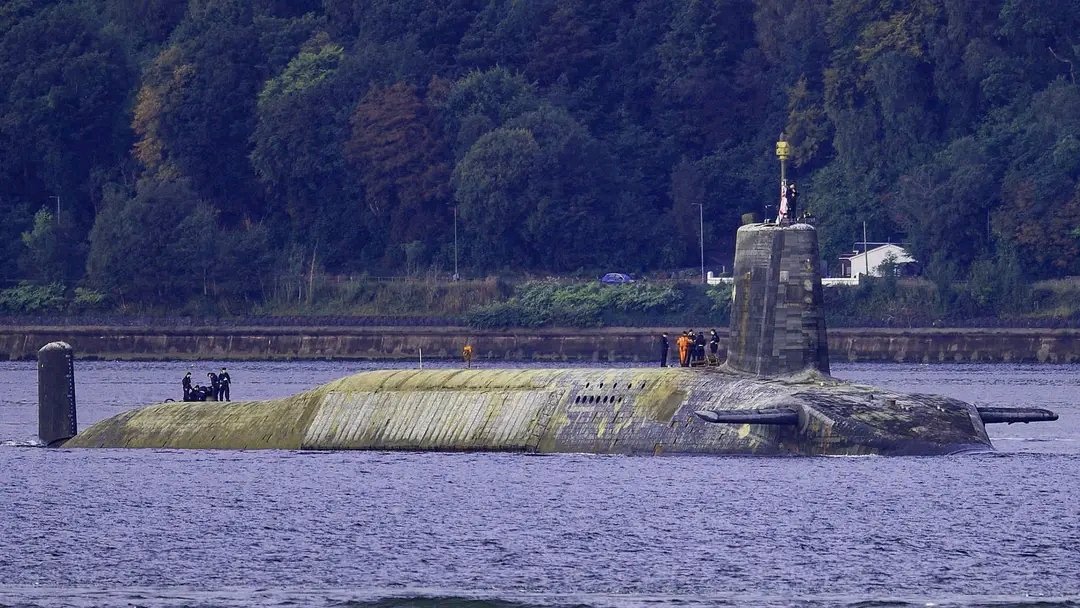The sight of a Royal Navy nuclear attack submarine (SSBN) coming to port completely caked in algae after a record of over six months of underwater deterrence deployment evoked awe for the fortitude of the crew and the unforgiving environments that these leviathans work in. However, it also indicates that the British SSBN fleet is getting long in the tooth.
Russia Could Lose The Ukraine War If It Does Not Escalate, But North Korea May Provide A Less Risky Option
The UK has maintained an operational fleet of SSBNs since 1998, and the country’s ballistic attack submarine has provided the country’s sole nuclear weapon capability. The Vanguard-class ballistic submarine carries the Trident missile system capable of delivering thermonuclear warheads.
The extended deterrence mission came in the 55th year of Operation Relentless, under which a British nuclear-attack submarine relentlessly patrolled the world’s oceans, “unseen, undetected, and ready to strike since 1969.”
The mission is the longest sustained military operation undertaken by the UK and is known as ‘the Continuous at Sea Deterrent.’ While the SSBNs by nature need to dive into the depths of oceans and remain holed up to avoid detection, six months without fresh air and a glimpse of light has been a feat for the crew of the three-decades-old submarines.
The Vanguard class submarine returned to HM Naval Base Clyde, on the west coast of Scotland, and was received by the Deputy Prime Minister of the UK and families of the crew members. The mission and name of the submarine remain classified due to the nature of their job.

Experts have questioned the raison d’être behind the extended patrol mission for six months as the regular deployments are generally two to three months. Hans Kristensen, the director of the Nuclear Information Project, Federation of American Scientists, said on social media X: “Six Months!? They normally last 2-3 (months). If so, does Britain have a problem with one of its other SSBNs? One of the 4 is in refueling overhaul, 1 is on patrol, and the 2 others are supposed to be able to replace it or join it at sea. Or a test of max endurance?”
A former Royal Navy submariner also questioned the reason for elongated patrol periods: “One has to fear for the crew’s mental health. No wonder retention of people is a severe problem. Six-month patrol submerged. Some, if not all, of the crew must have mental health problems. A mind-bending length of time. If invited to do this, I almost certainly would have declined.”
There are four Vanguard-class SSBNs in the Royal Navy. Built to operate for 25 years, they are past their time and have been in operation for nearly four decades. This means more extended maintenance and repair work. Only two of the undersea steel sharks – HMS Vigilant and HMS Vengeance – have been operational. The long duration of operations put considerable strain on the machine and the men behind it.
HMS Vanguard underwent a Long Overhaul that took seven-and-a-half years to complete. In November 2022, local media reported on a fire incident on HMS Victorious during a patrol, forcing it to return to base. The damage to HMS Victorious is not extensive. It would not affect the submarine’s ability to carry out deterrence patrols, but it does set the alarm bells ringing as to the shortage of SSBNs in its flotilla.
Preparation work has started on HMS Victorious ahead of a significant planned refit, which will keep the submarine on nuclear deterrence patrols into the 2030s. It is part of a Vanguard-class maintenance program in Devonport Naval Base in Plymouth at a specialist facility run by Babcock.
The successor of Vanguard submarines, the Dreadnought project, has been delayed due to domestic politics and financial woes. The project will cost around US$43 billion. The concept work did not start until 2007 and was approved only in 2011. Then, it was not until October 2016 that steel was cut on HMS Dreadnought, the first of the Dreadnought class SSBNs.
The Dreadnoughts are expected to join the force in the 2030s and have to maintain a tight schedule to meet the deadline and start relieving the Vanguard class SSBNs. The first of the Dreadnought submarines will soon be entering Delivery Phase 3, which will see the completion of construction and the submarine starting sea trials. The other three boats under construction are HMS Valiant, Warspite, and King George VI.
It was announced in February 2023 that steel cutting had started on Warspite. In 2022, a US$2.47 billion contract was given to Rolls Royce and BAE Systems to kick off the third phase of construction on the Dreadnought future submarine program.
The fate of the AUKUS SSN (nuclear-powered submarine) is also tied to the Dreadnought SSBN program. Construction of the SSNs will initially take place in the UK once it completes the Dreadnought project. Then, Australia is expected to move production of its later examples to new facilities in Adelaide.
Dreadnoughts Ruling The Waves
Much is not revealed about the Dreadnought class submarines except that they will have enhanced stealth features. They are the largest submarines made for the Royal Navy with a provision of mixed gender crew.
The ship will carry 12 Trident missile systems. It will feature a new lightning system that simulates day and night for the crew during a long submergence period.
Dreadnought will incorporate a new Turbo-Electric drive that uses a nuclear reactor to generate electricity. This will power Dreadnought submarines’ improved, quieter, and pumpjet propulsor.
- Ritu Sharma has been a journalist for over a decade, writing on defense, foreign affairs, and nuclear technology.
- She can be reached at ritu.sharma (at) mail.com